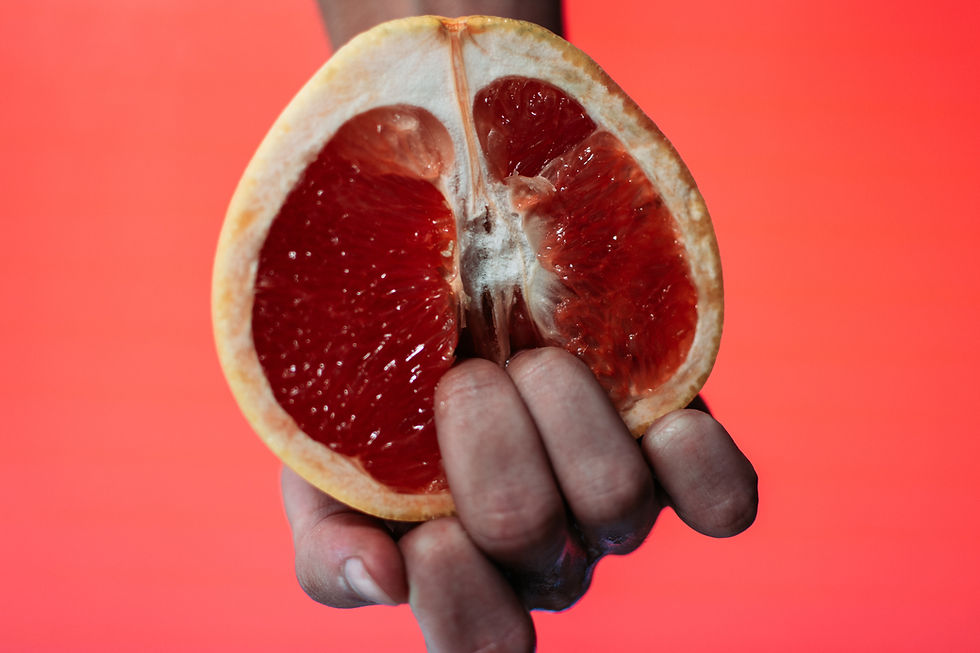P is for Pain
- Kiki Maree

- Oct 1, 2020
- 4 min read
Living with chronic or episodic pain disorders experienced by women and vulva havers such as endometriosis (endo), fibromyalgia (fibro), migraine, vaginismus, and vulvodynia (and others) presents unique challenges that can significantly impact our sexual health and intimate relationships (with both ourself and our lovers).
These conditions, often debilitating and misunderstood, can profoundly affect a person's physical, emotional, and sexual wellbeing. This article delves into how people grappling with these disorders can embrace their sexuality, celebrate small victories, and maintain fulfilling intimate relationships.
It is supppper important for people suffering with these disorders to take the expectations and pressure off of themselves when it comes to sex, sensuality etc. Unfortunately, sex and sensuality, just like other everyday life activities are oftentimes greatly impacted by these health issues. And just as we wouldn't expect someone with a chronic illness to show up in other everyday areas of life as a healthy person would, the same is true in sexuality.
Lets dive a little deeper.
Understanding Pain Disorders and Their Impact on Sexuality
Diverse Conditions and Common Challenges:
1. Some Common Pain Disorders experienced by women & vulva havers:
Conditions like endometriosis, where tissue similar to the womb's lining grows elsewhere, causing pain and fertility issues; fibromyalgia, characterized by widespread pain and fatigue; migraine, a complex neurological disorder; vaginismus, a condition causing involuntary muscle spasms in the pelvic floor (diaphragm); and vulvodynia, marked by chronic vulvar pain without an identifiable cause.
2. Bio-psycho-social Impacts on Sexuality:
Biological Impacts:
Chronic Pain and Sexual Function: Chronic pain can directly impact sexual function. Pain disorders can lead to decreased desire, difficulties in arousal, and pain during intercourse. For example, conditions like endometriosis or pelvic pain can make sexual activity painful.
Medication Side Effects: Many medications used to manage pain can also affect sexual function, such as antidepressants and opioids, which can decrease desire and cause difficulties in experiencing orgasm.
Mental Health and Self-Image: Chronic pain can lead to mental health issues such as depression, anxiety, and stress, which in turn can affect sexual desire and satisfaction. Additionally, chronic pain can impact one's body image and self-esteem, further influencing sexual wellbeing.
Fear of Pain or Flare-Ups: Individuals with episodic pain disorders may develop a fear of engaging in sexual activity due to the potential of triggering pain or a flare-up, leading to avoidance of sexual encounters.
Relationship Strain: Chronic pain can place a strain on relationships. Partners may struggle to understand the pain or may feel neglected if the individual with pain is less interested in sexual activity. This can lead to communication issues and emotional distance.
Social Isolation and Stigma: People living with chronic pain might experience social isolation, partly due to reduced participation in social activities, including intimacy. Furthermore, there can be a societal stigma around chronic pain and sexuality, making it challenging for individuals to seek support and discuss their experiences openly.
Overall Impact on Sexuality:
The cumulative effect of these biological, psychological, and social factors can significantly alter a person's sexual expression, experience, and satisfaction. It often requires a comprehensive approach, including medical treatment, psychological support, and open communication with partners, to address these challenges effectively.
Ways in which we can work with our pain in sexuality

Celebrating Every Step Forward
Acknowledging Progress: Recognizing small milestones such as pain-free moments, successful communication with partners, or understanding and accepting one's sexual needs and limits.
Finding Joy in Little Things: Engaging in self-care, seeking joy in non-sexual aspects of relationships, and sharing positive experiences with a support network can reinforce a sense of accomplishment and wellbeing.
Reimagining Intimacy and Sexuality
Open Communication and Consent: Honest conversations about limitations, pain, and sexual desires are crucial for a healthy sexual relationship.
Exploring Alternative Forms of Intimacy: Non-engulfment/penetrative sexual activities, sensual massages, oral sex, and the use of sex toys can offer pleasure without discomfort.
Self-Discovery: Understanding one’s body through gentle exploration can help identify what feels good and what to avoid, creating a more positive sexual self-image.
Shifting the Perspective on Responsibility
Partners’ Sexuality and Needs: People with pain disorders are not responsible for their partner’s sexual satisfaction. Relationships thrive on partners giving and recieving when and where they can, both to themselves and with their partners.
Respecting Boundaries: It's crucial to establish personal boundaries and to understand that declining sex due to pain or discomfort is completely valid.
Leveraging Support and Resources
Professional Guidance: Consulting healthcare providers, sex therapists, pain specialist, pain psychologists or pelvic floor (diaphragm) specialists can offer strategies to address sexual health concerns effectively.
Community Support: Joining support groups for specific conditions can provide comfort, shared experiences, and practical advice.
Insights from Recent Research
Relationship Dynamics: Studies have shown that while chronic pain can strain relationships, supportive partnerships, coupled with open communication, can create deeper understanding and intimacy.
Therapeutic Approaches: Research supports the benefits of therapies like mindfulness, pelvic floor rehabilitation, pain re-processing, and cognitive-behavioral therapy in improving sexual function and quality of life.
Advancements in Treatment: Ongoing medical research is continually shedding light on these conditions, offering new treatment options and hope for those affected.
People living with pain disorders face unique challenges in their sexual and intimate lives. However, by embracing small victories, exploring new ways to experience intimacy, and understanding the balance between personal health and relational dynamics, they can navigate their sexuality with dignity and positivity. Utilizing support systems, staying informed about recent advancements, and seeking professional advice are key to managing these conditions and maintaining a satisfying sexual life.
*This content is for informational purposes only and should not replace professional medical advice. Consulting a healthcare provider or a therapist is recommended for anyone dealing with pelvic pain disorders or related sexual health issues.




Comments